Medical disclaimer: This article is for informational purposes only and does not replace personalized veterinary advice. Always consult your veterinarian regarding your dog’s health and treatment options.
Table of Contents
INTRODUCTION
Dogs aren’t great at telling us when something’s wrong especially when it comes to mouth pain. They might continue eating, playing, and wagging their tails, all while silently suffering from inflamed gums or infected teeth. As a practicing veterinarian in Canada, I’ve diagnosed countless cases of advanced dental disease in dogs during routine checkups. Most of the time, pet parents are shocked there were no obvious signs, just a bit of bad breath or a slight change in eating habits.
Dental disease is more than a cosmetic issue. It’s a progressive, painful condition that can lead to tooth loss, gum infection, and even impact your dog’s vital organs like the heart, kidneys, and liver. In fact, over 80% of dogs over the age of three already show signs of periodontal disease. But here’s the good news: it’s highly preventable.
With the right tools, daily care routines, and a solid understanding of what to watch for, you can drastically reduce your dog’s risk of dental problems. Whether you have a teething puppy or a senior with some tartar buildup, this guide will walk you through the causes, signs, treatment options, and proven ways to prevent dental disease in dogs all from the perspective of a Canadian vet who’s seen firsthand how early intervention can make a life-changing difference.
Key Takeaways
Dental disease in dogs affects over 80% of dogs by age three, yet it’s one of the most preventable conditions. Brushing your dog’s teeth regularly, using VOHC-approved dental products, and scheduling veterinary checkups can help avoid painful infections and tooth loss. Small and brachycephalic breeds are especially vulnerable. Learn how to spot early signs, prevent plaque buildup, and manage costs effectively all from a Canadian veterinarian’s perspective.
What Is Dental Disease in Dogs?
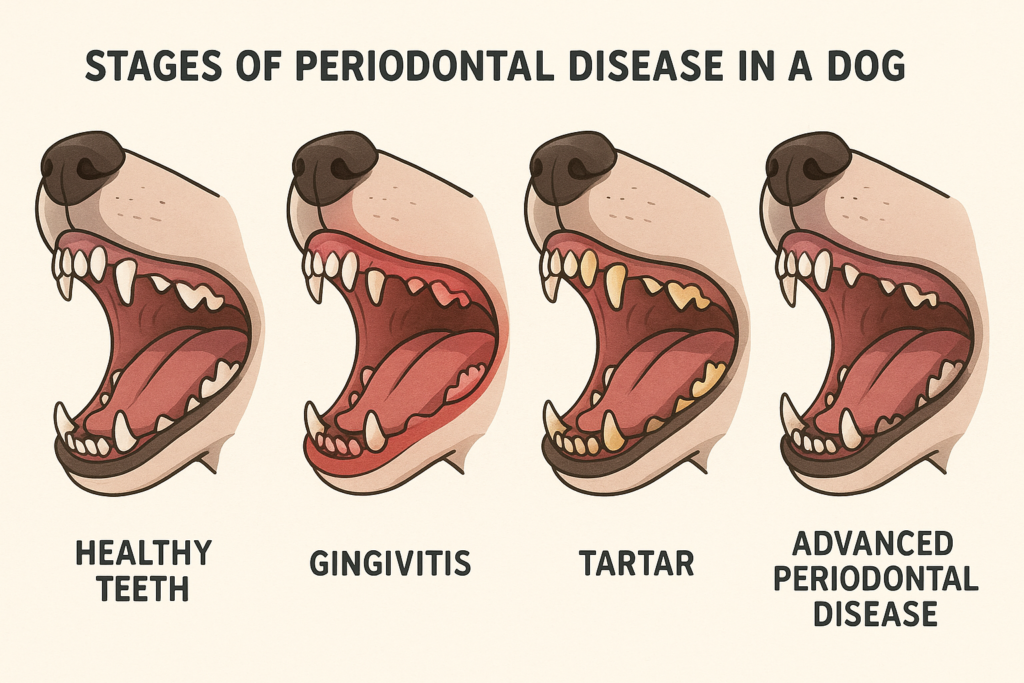
How Plaque Becomes Periodontal Disease
Dental disease in dogs begins quietly with bacteria. These bacteria form a sticky plaque on the surface of teeth. When plaque isn’t brushed away, it hardens into tartar (calculus), which irritates and inflames the gums. This early stage is called gingivitis. Without treatment, it progresses to periodontitis, where the infection spreads below the gumline, destroying the tissue and bone that hold the teeth in place.
In my Ottawa clinic, I often diagnose dogs with stage 2 or 3 periodontal disease usually during annual wellness exams because they rarely show outward signs until the damage is advanced.
Breeds at Higher Risk
Some dogs are genetically predisposed to dental disease in dogs. These include:
- Toy breeds like Chihuahuas, Yorkies, and Pomeranians due to their small mouths and crowded teeth
- Brachycephalic breeds like Bulldogs, Pugs, and Shih Tzus because of misaligned or overlapping teeth
- Greyhounds and Whippets despite long snouts, they often have poor dental enamel
Knowing your dog’s breed risk can help you take earlier and more aggressive preventive steps.
Causes of Dental Disease in Dogs
Also visit: https://doglifeexpert.com/top-8-digestive-problems-in-dogs/
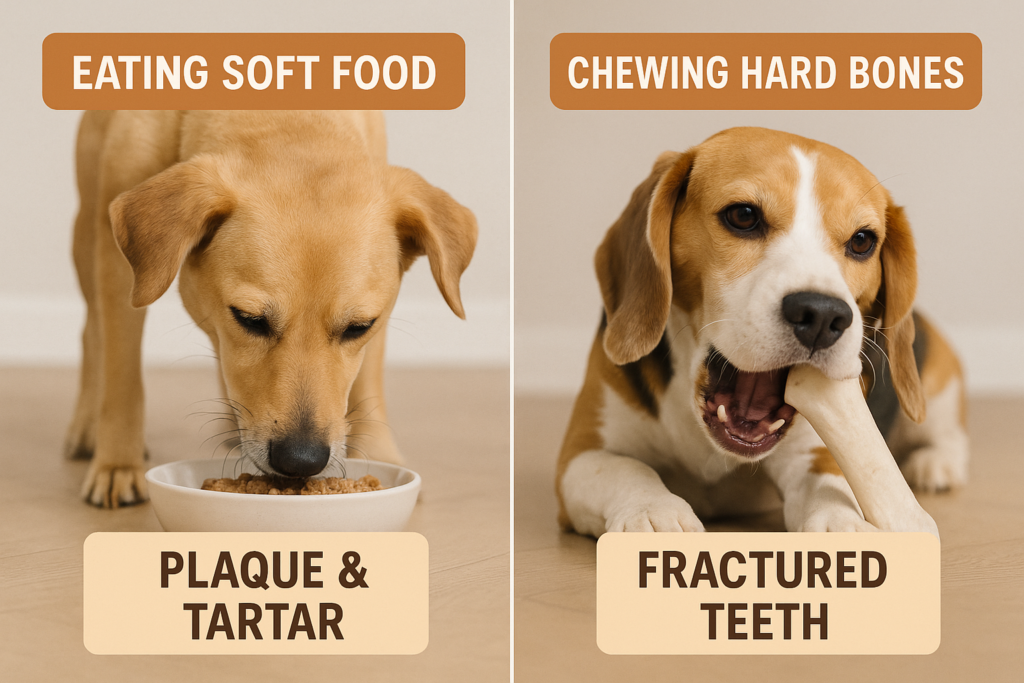
There’s no single cause behind dental disease in dogs it’s usually the result of multiple factors working together over time. While some dogs are naturally more predisposed to dental problems due to their genetics or anatomy, lifestyle choices like diet and chewing habits also play a big role. As a veterinarian, I often explain to pet owners that dental disease is both preventable and manageable if we address these key causes early.
🍽️ Diet: What Your Dog Eats Matters
What your dog eats directly affects their dental health. Dogs on soft, moist, or carbohydrate-heavy diets are at a higher risk of plaque accumulation. These types of food tend to stick to the teeth and provide fuel for bacteria in the mouth.
While dry kibble can be more abrasive and may help reduce some plaque buildup, not all kibbles are equally effective. Only specialized dental diets, like Hill’s Prescription Diet t/d or Royal Canin Dental, are clinically proven to reduce tartar thanks to their texture, size, and shape.
❗ Pro tip: Treats like bread crusts, table scraps, and starchy commercial snacks can quietly contribute to dental disease in dogs, especially when combined with inconsistent oral hygiene.
🧼 Lack of Oral Hygiene
Just like humans, dogs require regular oral care. Without brushing, bacteria-laden plaque starts forming within hours of eating. If it’s not removed, it hardens into tartar in just a few days.
In my clinic, I often see dogs as young as 12–18 months with early signs of gingivitis simply because brushing wasn’t introduced at home. Skipping this daily step allows bacteria to multiply, invade the gumline, and eventually lead to inflammation and bone loss.
💡 Even brushing just three times a week can cut your dog’s plaque burden by more than 70%.
🧬 Breed and Genetics
Some dogs are genetically predisposed to dental disease in dogs, especially those with small jaws or crowded teeth. These anatomical features create hard-to-reach crevices where food particles and bacteria collect.
Breeds at higher risk include:
- Small breeds: Chihuahuas, Yorkies, Toy Poodles, Papillons
- Brachycephalics: Pugs, French Bulldogs, Shih Tzus
- Greyhounds and Whippets: Known for thinner enamel and gum recession
Owners of these breeds must be extra vigilant with brushing and may need more frequent dental exams or cleanings.
🧓 Age: Dental Disease Progresses Over Time
As dogs age, their risk of dental disease increases significantly. By age three, more than 80% of dogs show signs of periodontal disease. Older dogs tend to accumulate more plaque, and their immune systems may not respond as efficiently to bacterial infections in the mouth.
In senior pets, untreated dental disease in dogs often leads to systemic complications such as endocarditis (heart infection), chronic kidney disease, or liver inflammation. That’s why we encourage pet parents to maintain a lifelong oral care plan, not just start when their dog is older.
🦷 Chewing Habits: Too Hard Can Hurt
It’s a common myth that giving your dog bones or antlers helps “clean” their teeth. In reality, hard chews often do more harm than good. I’ve seen countless fractured premolars and broken canines caused by:
- Deer antlers
- Marrow bones
- Hard nylon chews
- Compressed rawhides
Fractured teeth expose the pulp cavity, allowing bacteria to enter and trigger abscesses. Worse still, many dogs continue eating normally, masking the pain.
Instead, I recommend VOHC-approved dental chews made from digestible, flexible material that safely reduce plaque without risking tooth injury.
👩⚕️ Clinical Insight: Common Owner Mistakes
In my day-to-day practice, one of the most frequent oversights I see is pet parents relying solely on dental treats. While they can help, they’re no substitute for brushing. Another issue is giving dogs “natural” chews that are too hard, leading to preventable dental trauma.
Educating owners about these risks and offering better alternatives goes a long way in reducing cases of dental disease in dogs.
Everyday Risk Factors in Canadian Homes
In Canadian households, indoor dogs may have fewer chewing opportunities, especially in winter when walks are shorter. Also, many popular treats sold at big-box stores are not VOHC-approved and do little to help. Understanding these subtle risks can make all the difference in preventing dental disease in dogs.
Early Signs You Shouldn’t Ignore
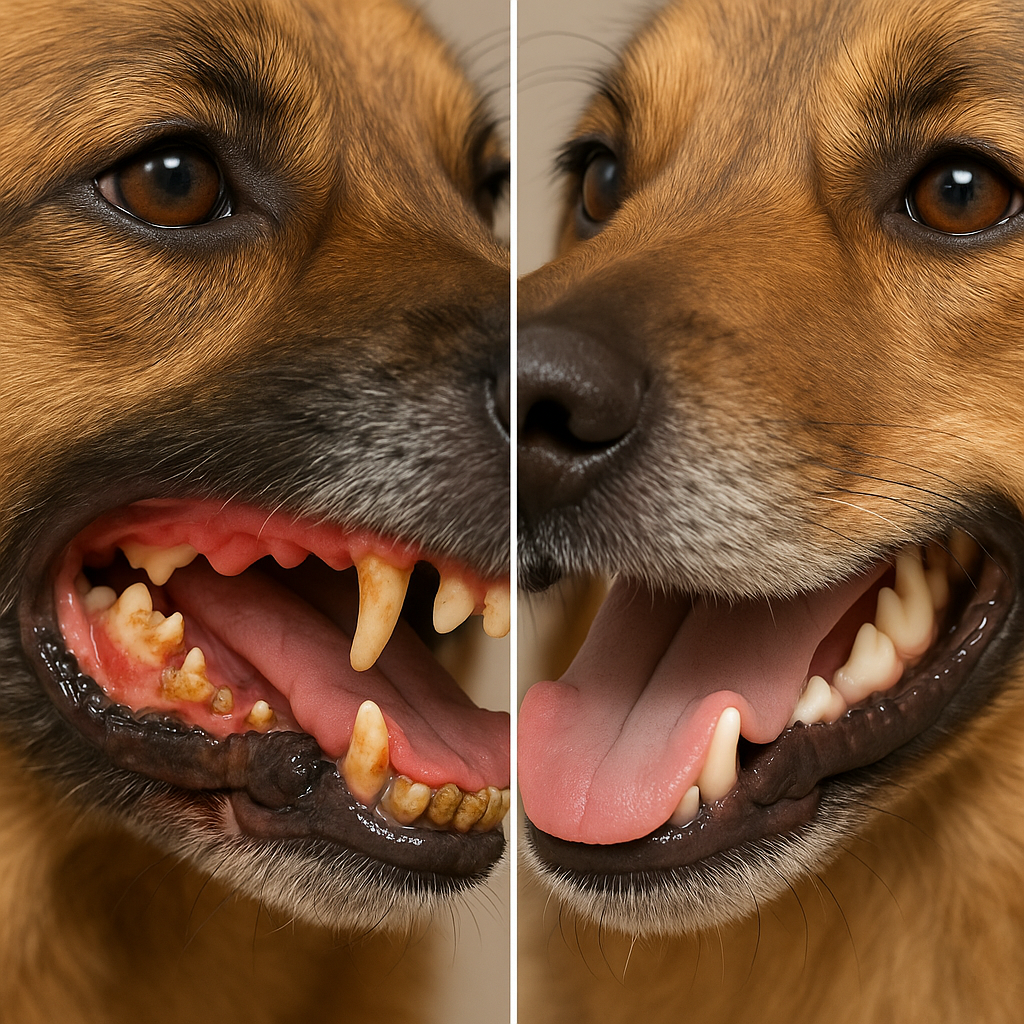
Catching dental disease in dogs early can save your pet from pain and you from costly treatments. Here’s what to watch for:
- Bad breath: Often the first red flag. If your dog’s breath is consistently foul, don’t dismiss it.
- Red or bleeding gums: Healthy gums should be pink. Inflamed or bleeding gums signal gingivitis.
- Dropping food or chewing on one side: These signs indicate discomfort when eating.
- Visible tartar: Yellow or brown buildup on teeth is hardened plaque.
- Loose or missing teeth: A hallmark of advanced dental disease in dogs.
- Pawing at the mouth or face rubbing: These behaviors often signal pain or irritation.
- Reluctance to play or eat hard food: Dental discomfort can change a dog’s behavior significantly.
🕔 5-Minute Home Mouth Check
Once a month, do a quick dental check at home:
- Lift the lips to examine teeth and gums.
- Look for redness, swelling, or tartar buildup.
- Smell your dog’s breath.
- Note if your dog resists this can be a subtle sign of pain.
If anything looks or smells unusual, schedule a veterinary dental exam. I’ve diagnosed early-stage dental disease in dogs during routine wellness visits simply because an owner noticed a small change at home.
How to Prevent Dental Disease in Dogs
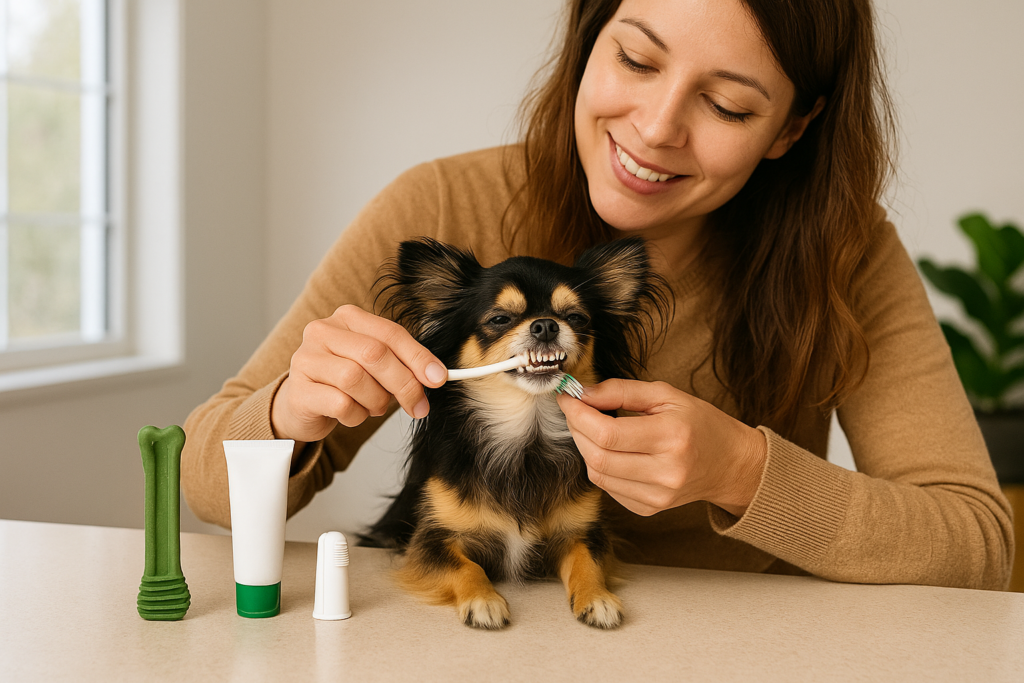
Preventing dental disease in dogs is easier and cheaper than treating it. A consistent at-home routine, combined with professional guidance, can keep your dog’s mouth healthy for life.
Daily Brushing Tips from a Vet
Brushing your dog’s teeth daily is the gold standard. Here’s how I coach my clients:
- Use the right tools: A dog-specific toothbrush or finger brush and enzymatic toothpaste (like Virbac C.E.T.) are essential. Never use human toothpaste.
- Build slowly: Start by letting your dog lick the toothpaste. Gradually introduce brushing with lots of praise.
- Aim for consistency: Even brushing 3–4 times a week can dramatically reduce plaque.
- Focus on the outer surfaces: That’s where plaque builds up most.
Daily brushing is the most effective way to prevent dental disease in dogs, especially in breeds with crowded mouths or a history of dental issues.
Best VOHC-Approved Products
The Veterinary Oral Health Council (VOHC) approves products proven to reduce plaque and tartar. Some options I recommend:
| Product Type | Examples |
|---|---|
| Dental diets | Hill’s t/d, Royal Canin Dental |
| Dental chews | Greenies, Oravet, Whimzees |
| Water additives | TropiClean, HealthyMouth |
| Dental treats | Purina DentaLife, Milk-Bone Brushing Chews |
Look for the VOHC seal to ensure the product is clinically tested for effectiveness. These help control dental disease in dogs, especially when used alongside brushing.
Safe Toys vs Risky Chews
Avoid hard items that could crack teeth:
- ❌ Antlers, bones, nylon chews
- ✅ Softer rubber toys, dental ropes, VOHC chews
A good rule: If it hurts to press your thumbnail into the chew, it’s probably too hard for your dog’s teeth.
When to Start (Puppy and Senior Advice)
- Puppies (8+ weeks): Begin brushing early to make it a normal part of their routine.
- Seniors: Start slow and focus on gentler methods, like wipes and dental gels, if brushing causes discomfort.
Starting early and staying consistent reduces the risk of dental disease in dogs at every life stage.
What to Do if Your Dog Has Dental Disease
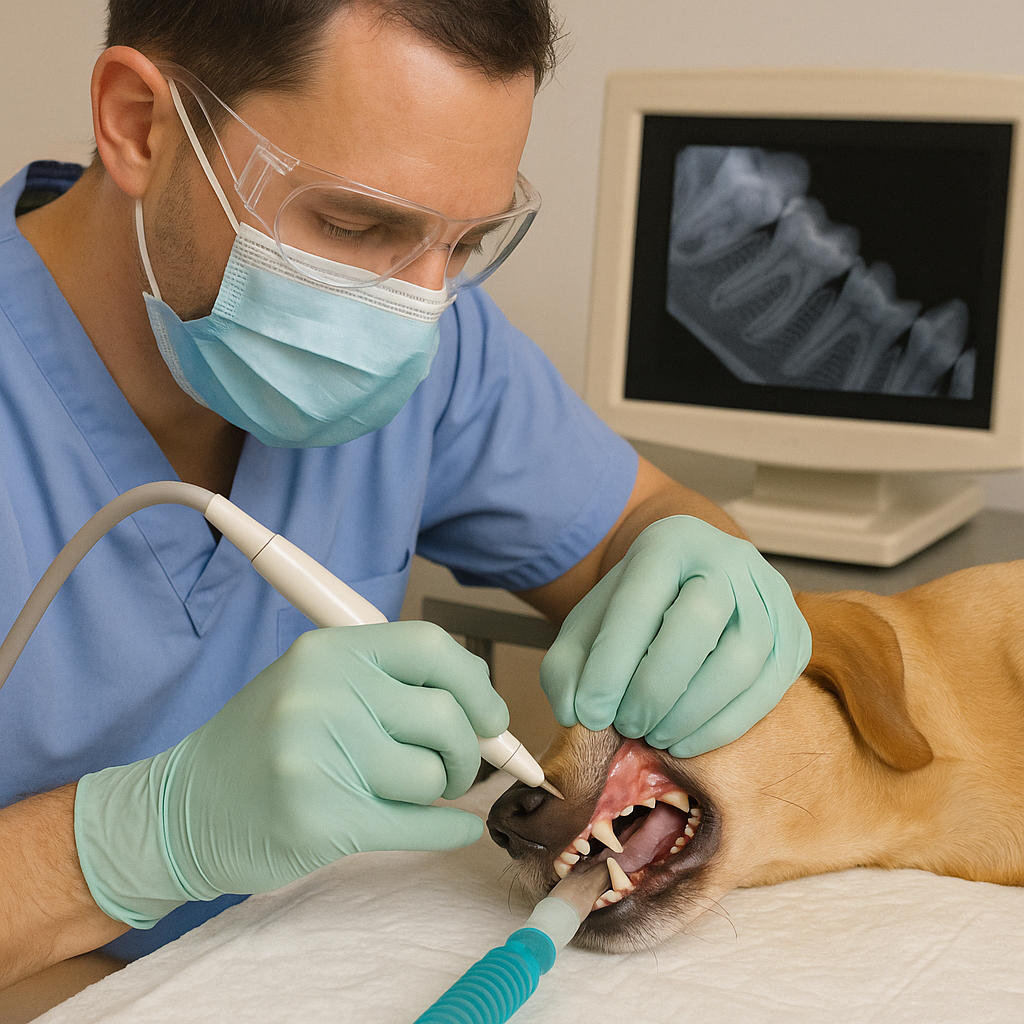
When signs of dental disease in dogs are already present, a vet visit is the first and most important step. Treatment depends on how advanced the disease is.
Professional Cleaning (Costs in Canada)
Veterinary dental cleanings are done under anesthesia and typically include:
- Scaling and polishing to remove tartar above and below the gumline
- Dental X-rays to evaluate the health of tooth roots and surrounding bone
- Extractions if teeth are loose, fractured, or infected
In Canada, typical costs for professional dental cleaning:
| Service | Estimated Cost (CAD) |
|---|---|
| Basic dental cleaning | $350–$700 |
| X-rays (full mouth) | $150–$300 |
| Extractions (per tooth) | $50–$200 |
| Bloodwork (pre-anesthetic) | $75–$150 |
Pet insurance may help offset some of these costs, but coverage varies.
Medications and Home Aftercare
If infection is present, your vet may prescribe:
- Antibiotics (e.g., Clavamox, metronidazole) to treat infection
- Pain relief (e.g., carprofen or meloxicam) for inflammation
- Topical products like Oratene gel to soothe irritated gums
After dental surgery or extractions, soft food and gentle care are key. Monitor for:
- Swelling or bleeding
- Refusal to eat
- Drooling or pawing at the mouth
Resume brushing only after your vet clears it usually 1–2 weeks post-treatment. This helps prevent recurrence of dental disease in dogs.
Adjusting Diet for Painful Mouths
Dogs recovering from dental work or those with chronic disease may need diet changes:
- Switch to softened kibble or canned food
- Feed smaller, more frequent meals
- Choose VOHC-approved soft diets if long-term change is needed
Ask your vet to guide your feeding plan so your dog still gets the right nutrients while healing.
Managing Long-Term Cases
Some dogs may need repeat cleanings or multiple extractions. I’ve treated dogs with nearly all their teeth removed and they still eat well and thrive.
For chronic dental disease in dogs, long-term care includes:
- Regular dental exams (every 6–12 months)
- At-home plaque control (brushing, gels, water additives)
- Monitoring for signs of recurrence (bad breath, drooling, food aversion)
Breed-Specific Advice
Certain breeds need extra dental attention due to their anatomy and genetics. As a Canadian veterinarian, I routinely adjust dental care plans based on breed.
🐾 Dental Disease Risk by Breed Type
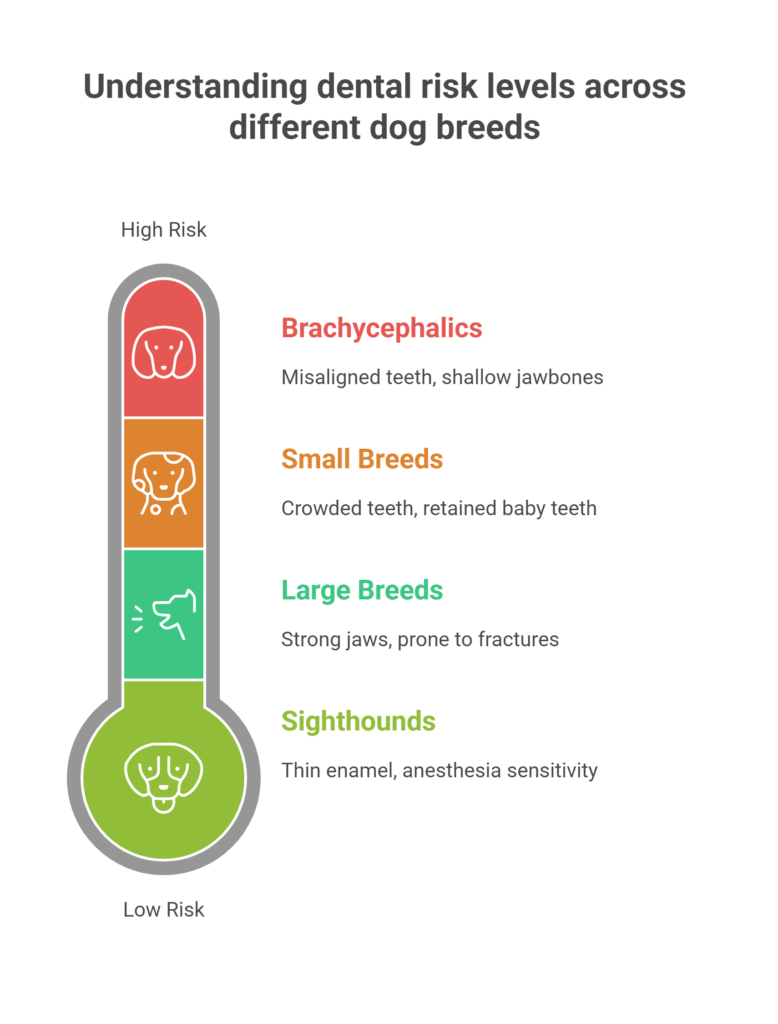
Even mixed breeds can inherit traits that predispose them to dental disease in dogs. Talk to your vet about your dog’s specific needs.
Typical Costs in Canada
Proactive dental care saves money in the long run. Here’s what dog owners in Canada can expect to spend:
| Item or Service | Estimated Monthly/Annual Cost (CAD) |
|---|---|
| Enzymatic toothpaste & toothbrush | $10–$15/month |
| VOHC-approved dental chews | $20–$40/month |
| Dental diet (Hill’s t/d, Royal Canin) | $30–$90/month (based on dog size) |
| Professional cleaning (basic) | $350–$700 per year |
| Extractions or advanced treatment | $500–$2,000+ |
Preventing dental disease in dogs costs a fraction of what treatment does. Prioritize brushing and VOHC-approved products to save both money and your dog’s discomfort.
FAQs About Dental Disease in Dogs
1. Does my dog really need their teeth cleaned?
Yes. Just like humans, dogs develop plaque and tartar. Without regular cleanings, this leads to dental disease in dogs which can cause pain, infections, and tooth loss.
2. Is it safe to put my dog under anesthesia for a dental cleaning?
In most cases, yes. Your veterinarian will perform pre-anesthetic bloodwork to ensure your dog is healthy enough. Anesthesia allows for thorough cleaning below the gumline and dental X-rays, which are crucial in diagnosing hidden disease.
3. What happens if I don’t treat dental disease?
Untreated dental disease in dogs can lead to tooth loss, jaw bone infections, chronic pain, and bacteria spreading to vital organs like the heart, liver, and kidneys.
4. Are dental chews alone enough to prevent dental disease?
No. While VOHC-approved chews help reduce plaque, they are not a replacement for brushing. Combine them with brushing and regular vet visits for best results.
5. Can dogs live without teeth?
Yes! Dogs adapt well to tooth loss. They may need softer diets, but many eat, play, and thrive even with no teeth as long as pain and infection are treated.
6. How often should my dog have a dental checkup?
Most dogs benefit from a dental exam at least once a year. For dogs already diagnosed with dental disease in dogs, exams every 6 months may be recommended.
Final Thoughts
Dental disease in dogs is common but largely preventable. With daily brushing, VOHC-approved products, and regular veterinary care, you can protect your dog from unnecessary pain, tooth loss, and expensive treatments. It’s never too late to start whether you have a teething puppy or a senior with bad breath.
As a veterinarian, I’ve seen dogs transform after proper dental care. They eat better, play more, and act years younger. Don’t wait until there’s a problem. Make oral health part of your dog’s daily routine, and they’ll thank you in tail wags.

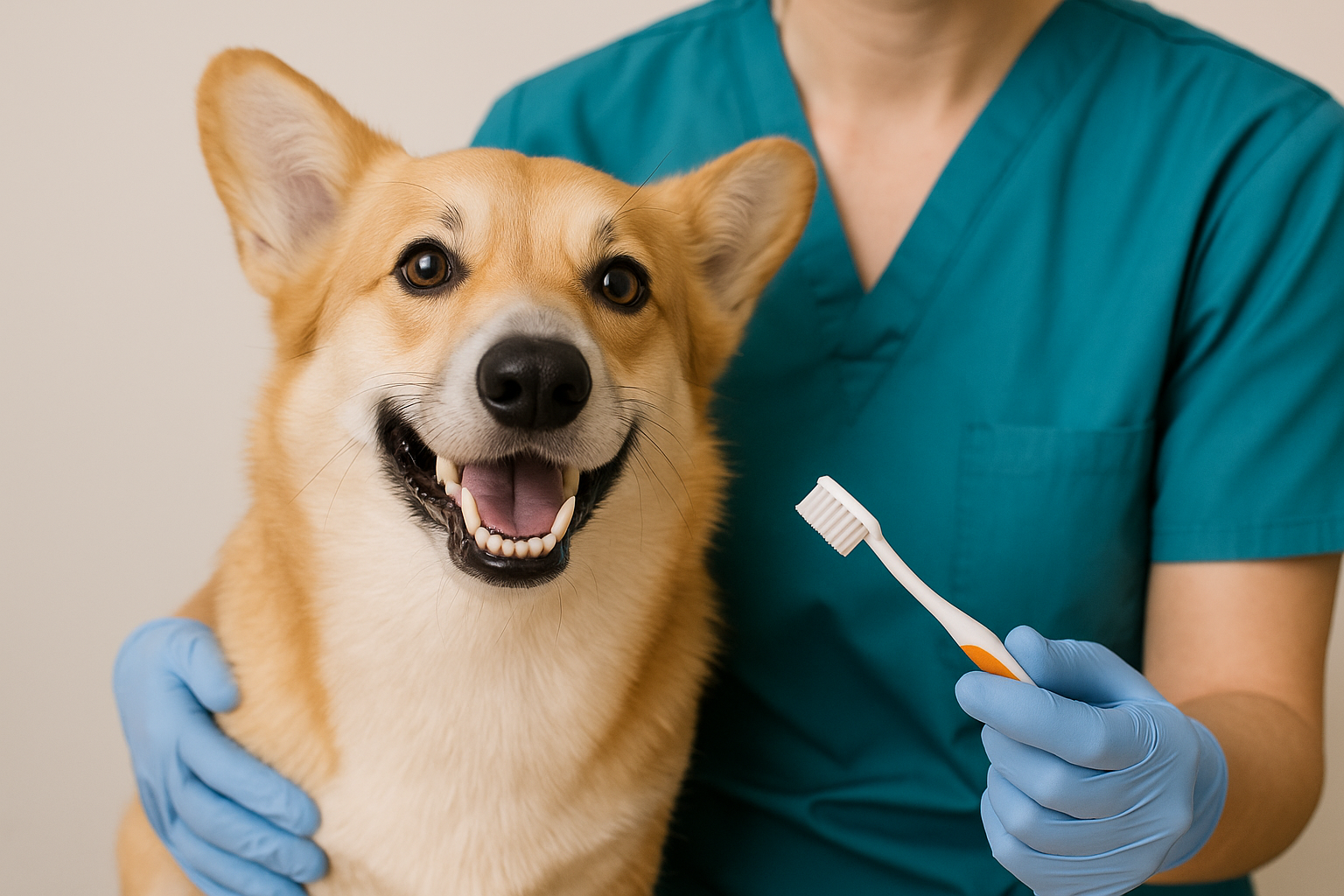
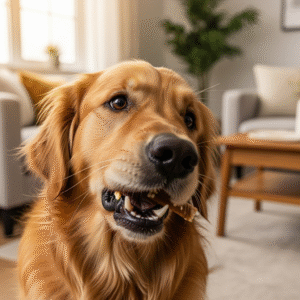


Pingback: "Dog Diarrhea: 10 Best Expert-Backed Home Remedies That Actually Work"
Pingback: Canine Periodontal Disease: 7 Proven Ways to Prevent It